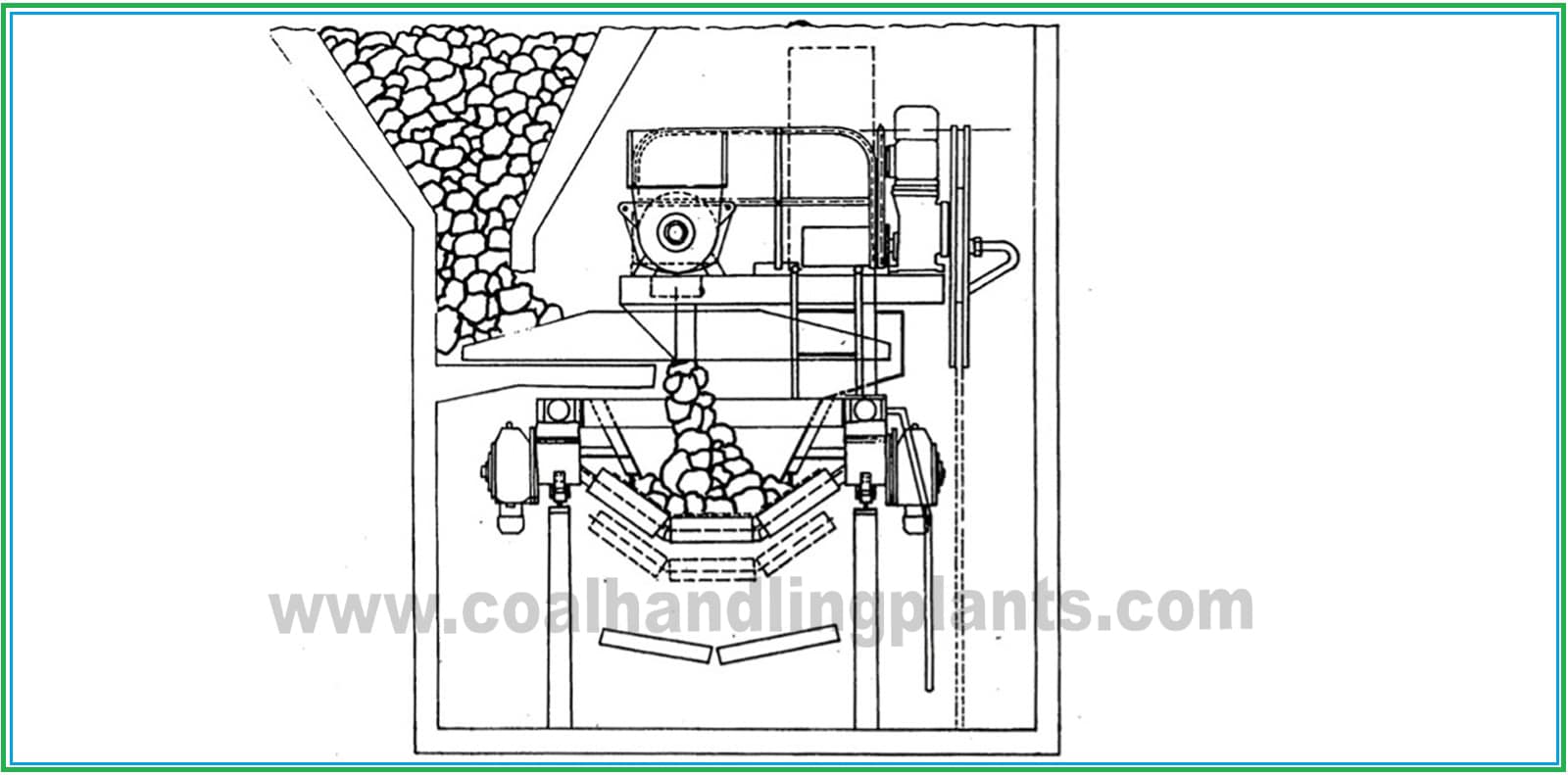Paddle Feeder / Rotary Plough Feeder are the conveyor belt feeder which are used for extraction of loose material from stock-pile, silos and bottom discharge wagon system.

Only the bulk material in the angle of repose is discharged from the bunker table and onto a conveying system underneath, such as a belt conveyor.This arrangement is used for free flowing bulk material because new material freely flow downward to replace material which has previously been discharged.As a material flows through the gates , its angle of repose will stop the flow of material.For cohesive and difficult flowing bulks materials, the discharge paddle not only discharge from the angle of repose, but it deeply penetrates the bulk material.The degree of penetration of the discharge paddle depends upon the flowability of the bulk material, i.e the internal friction of the material. The penetration must be sufficient so that the bridge formed by the bulk material are continuously destroyed during discharge by the vertical pressure head of the material above.
Main Components of Paddle Feeder / Rotary Plough Feeder
-
Paddle Drive
Paddle drive of paddle feeder consists of a hydraulic motor with power pack and planetary gear box.Output shaft of the planetary gear box connects the paddle blade . To protect against possible over loading an effector actuating relay is provided on the output shaft of the planetary gear box.A sensing prob fitted on the output shaft gives pulse signal to the proximatery switch. This pulse count , is less then the set count,(to indicate jamming) trips the power to travel and paddle drives. This limit has to be adjusted on relay per unit between 6 to 20 pulse counts per minute.
Working Of Paddle Drive
As soon as electric motor is switch ON , oil will flow from pump 1 lpm to 155 lpm and will return to tank pressure less through directional control valve , air oil cooler and return line filter. As oil is returned pressure less the electric motor shall start on no load condition.
As soon as solenoid of directional control valve is energized oil will flow from pressure (P) port of directional control valve to A port to hydraulic motor through bulk head A of the power pack. Hydraulic motor will rotate and the return oil will come back to reservoir through B port and Tank(T) port of directional control valve to air oil cooler and through return line filter. System pressure to be set is 100 bar. Pressure can be on pressure gauge by pressing know of gauge isolater valve. There is possibility of controlling the speed of Hydro- Motor through variable delivery axial position pump and through throttle valve. At the 0 degree pump flow will be zero.
-
Travel Drives
Paddle feeder travel drive consisting of geared motor with integral break each pair of wheel are driven by one horizontally( with torque arm ) geared motor i.e 2 nos of geared motor are required per equipment.Both the drives shall be reversible in nature and synchronously driven.
The cable reeling drum of paddle feeder is used to transfer electric power through cable from junction box located at centre or end of runway to moving machine.The CRD serves winding and unwinding of the cable automatically.
Warning For Paddle Feeder / Rotary Plough Feeder
- Start the paddle drive first and then travel drive.
- Stop the travel drive first and then paddle drive.
- Allow the paddle blade to achieve requisite speed and make it travel into the material.
Work Involved During Preventive Maintenance Of Paddle Feeder In Coal Handling Plant
During preventive maintenance of paddle feeder following equipments are checked step by step and detected problems are corrected.
- Long Travel Drive – Check for oil Leakage, Gear box oil Level and condition, Wheel condition, Condition of Rail Clamp, Stopper condition.
- Hydraulic Power Pack – Check for power pack tank condition, condition, oil level and gauge glass condition, Breathe or Silica jell condition, Oil Coolant Fan, connecting hose & line condition.
- Paddle Wheel Assembly – Check for Hydraulic Motor, planetary Gear Box condition, Blade Liner Condition.
- Chain Sprocket For CCRD & PCRD – Check for chain condition, chain lubrication, chain sprocket condition, chain & sprocket Guard condition,
- Coupling – Check for Coupling condition.
- Dust Suppression System – Check for Nozzle condition, Tank condition, hose condition & pump condition.
- PCRD and CCRD Drum – Check for drum condition, Check for guide roller condition.
- Gear Box – Check for lubrication & any leakages.
- Oil Cooling Fan – Check for oil connecting hose condition & Radiator condition.
- Foundation Bolt – Check for foundation bolt condition.
- House Keeping Status – Check Housekeeping status.
- Waste Management – Check for scrap /waste.
-
RELATED SEARCHES:
